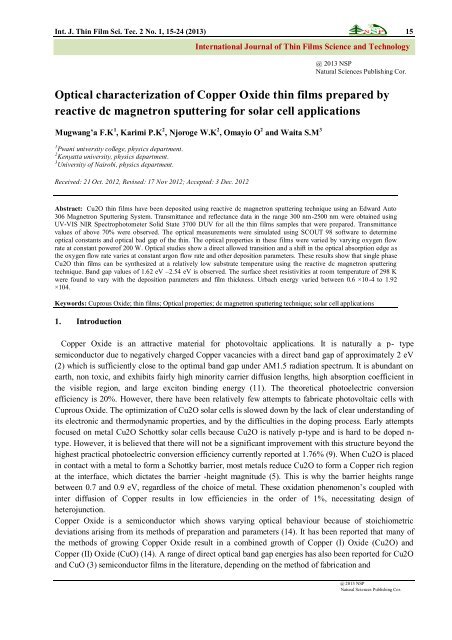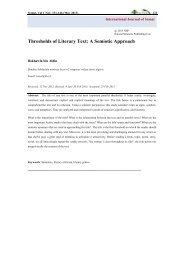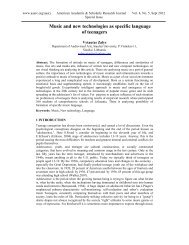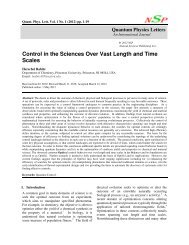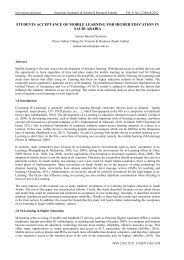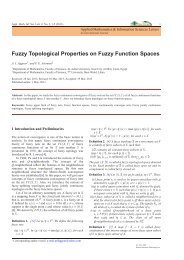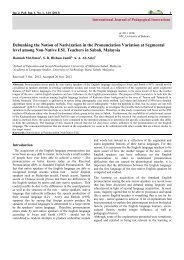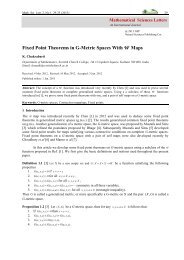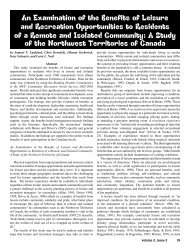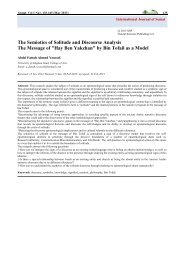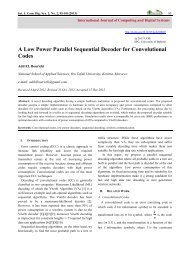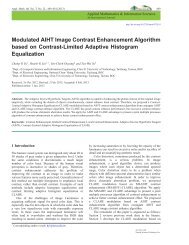Optical characterization of Copper Oxide thin films prepared by ...
Optical characterization of Copper Oxide thin films prepared by ...
Optical characterization of Copper Oxide thin films prepared by ...
Create successful ePaper yourself
Turn your PDF publications into a flip-book with our unique Google optimized e-Paper software.
16 Mugwang’a F.K, et al: <strong>Optical</strong> <strong>characterization</strong> <strong>of</strong> <strong>Copper</strong> <strong>Oxide</strong> …stoichiometry. Sputter deposition <strong>of</strong> <strong>Copper</strong> <strong>Oxide</strong> <strong>films</strong> on glass are reported to have high transparency,with a slightly yellowish appearance, and absorbs usually at wavelengths below 600 nm, whilst CuOabsorbs strongly throughout the visible spectrum and is black in appearance. The current applications areas<strong>of</strong> <strong>Copper</strong> <strong>Oxide</strong> <strong>thin</strong> <strong>films</strong> include solar cells and electro-chromic devices (17). <strong>Copper</strong> <strong>Oxide</strong> <strong>films</strong> havebeen reported to have band gap energy values which make them suitable for application as absorbers forsolar energy conversion (Ogwu et al., 2005).<strong>Copper</strong> <strong>Oxide</strong> semiconductors have been studied for several reasons such as: the natural abundance <strong>of</strong>starting material <strong>Copper</strong> (Cu); the ease <strong>of</strong> production <strong>by</strong> <strong>Copper</strong> oxidation; their non-toxic nature and thereasonably good electrical and optical properties exhibited <strong>by</strong> Cu2O. Cupric <strong>Oxide</strong> (CuO) is a p-typesemiconductor having a band gap <strong>of</strong> 1.21–2.1 eV and monoclinic crystal structure (3). Cuprous oxide(Cu2O) is also a p-type semiconductor having a band gap <strong>of</strong> approximately 2.2 - 2.9 eV and a cubic crystalstructure (3). Its high optical absorption coefficient in the visible range and reasonably good electricalproperties constitute important advantages and render Cu2O as the most interesting phase <strong>of</strong> copper oxides(3). Several methods such as: thermal oxidation (13); electrodeposition (15); chemical conversio, chemicalbrightening (14); spraying (3); chemical vapor deposition (20); plasma evaporation (3); reactive sputtering(4); and molecular beam epitaxy (8) have been used to prepare <strong>Copper</strong> <strong>Oxide</strong> <strong>thin</strong> <strong>films</strong>. In most <strong>of</strong> thesestudies, a mixture <strong>of</strong> phases <strong>of</strong> Cu, CuO and Cu2O is generally obtained and this is one <strong>of</strong> the naggingproblems for non-utilizing Cu2O as a semiconductor. Pure Cu2O <strong>films</strong> can be obtained <strong>by</strong> oxidation <strong>of</strong><strong>Copper</strong> layers wi<strong>thin</strong> a range <strong>of</strong> temperatures followed <strong>by</strong> annealing for a small period <strong>of</strong> time. Cu2O isone <strong>of</strong> the oldest semiconducting materials which are useful in solar cell applications.Balamuruga and Mehta, (3) studied nanocrystalline Cu2O <strong>thin</strong> <strong>films</strong>. The <strong>films</strong> were synthesized using anactivated reactive evaporation technique. Structural and optical <strong>characterization</strong>s <strong>of</strong> these <strong>films</strong> werecarried out using, glancing angle X-ray diffractometer; Fourier transform infrared spectrometer;transmission electron microscope; and UV-VIS-NIR spectrophotometer. The nanocrystalline size in these<strong>films</strong> was varied <strong>by</strong> changing the deposition parameters. Furthermore, optical spectroscopy studies onnanocrystalline Cu2O showed a direct allowed transition and a shift in the optical absorption edge from thebulk value with nanocrystalline size and stoichiometry <strong>of</strong> these <strong>films</strong>. These results show that a singlephase nanocrystalline Cu2O <strong>thin</strong> <strong>films</strong> can be synthesized at a relatively low substrate temperature usingthe activated reactive evaporation technique. These studies indicate that nanocrystallinity results in thestability <strong>of</strong> cubic Cu2O phase in these <strong>films</strong>.Papadimitropoulos (16) studied <strong>Copper</strong> <strong>Oxide</strong> <strong>films</strong> which were grown <strong>by</strong> oxidation <strong>of</strong> vacuumevaporated <strong>Copper</strong> layers on silicon substrates. Oxidations were performed at atmospheric pressure, in anitrogen–oxygen mixture 10% in oxygen and at temperatures varying between 185 °C and 450 °C, theoptical properties <strong>of</strong> <strong>films</strong> were studied with spectroscopic ellipsometry measurements wi<strong>thin</strong> the energyrange 1 to 3.5 eV. These measurements were analysed using the Tauc–Lorentz (TL) model (16) to simulatethe dispersion <strong>of</strong> the complex refractive index <strong>of</strong> disordered <strong>films</strong>. It was shown that the TL modeldescribes satisfactorily the refractive index dispersion <strong>of</strong> these <strong>Copper</strong> <strong>Oxide</strong> <strong>films</strong>. The band gap, asdefined <strong>by</strong> the TL model, was found equal to 2.3 eV for Cu2O and between 1.05 eV and 1.2 eV for CuO. Itwas shown that the gap <strong>of</strong> the Cu2O <strong>films</strong> was free <strong>of</strong> localized states, which was not the case for the gap<strong>of</strong> CuO.Ogwu et al., (14) sputtered <strong>Copper</strong> <strong>Oxide</strong> <strong>films</strong> on glass substrates <strong>by</strong> reactive radio frequency (rf)magnetron sputtering, using a solid <strong>Copper</strong> target and an Argon–Oxygen gas atmosphere. <strong>Optical</strong>transmission in the <strong>prepared</strong> <strong>films</strong> was measured <strong>by</strong> spectrophotometer in the 400–850 nm wavelengthregions. A maximum transmission <strong>of</strong> between 40% and 80% for <strong>Copper</strong> <strong>Oxide</strong> <strong>films</strong> <strong>prepared</strong> at a low rf
Mugwang’a F.K , et al: <strong>Optical</strong> <strong>characterization</strong> <strong>of</strong> <strong>Copper</strong> <strong>Oxide</strong> … 17power <strong>of</strong> 200 W was observed, for the Oxygen flow rates investigated. The optical band gap values <strong>of</strong> the<strong>films</strong> ranged between 2.05 and 2.4 eV. Hailing Zhu (6), <strong>prepared</strong> Cu2O <strong>thin</strong> <strong>films</strong> on quartz substrate <strong>by</strong>reactive direct current magnetron sputtering. The influences <strong>of</strong> Oxygen partial pressure and gas flow rateon the structures and properties <strong>of</strong> deposited <strong>films</strong> were investigated. The as-deposited Cu2O <strong>films</strong> werefound to have a very high optical absorption in the visible spectra under 600 nm and were endowed withphotocatalytic reactivity under the visible light.In dc reactive magnetron sputtering, the physical properties <strong>of</strong> the deposited <strong>films</strong> critically depend on thesputtering parameters such as oxygen partial pressure, sputtering pressure, substrate temperature,sputtering power and distance from the target to the substrate. Post deposition annealing or deposition athigher substrate temperature has been found to result in these <strong>films</strong> having predominant Cu2O phase (18).In this paper, we reported the results <strong>of</strong> depositing nano- structured Cu2O <strong>thin</strong> <strong>films</strong> <strong>by</strong> dc reactivemagnetron sputtering process under the effect <strong>of</strong> oxygen flow rate on the optical properties <strong>of</strong> these Cu2O<strong>thin</strong> <strong>films</strong> was also investigated.2. Experimental techniques2.1 Preparations <strong>of</strong> <strong>thin</strong> <strong>films</strong>The glass substrates were cleaned in dilute chromic acid to remove metallic particles and organic stains orsurface contaminants and thereafter rinsed thoroughly with distilled water and ethanol to remove anyacidic residues and allowed to dry completely. The substrates were then introduced into the vacuumchamber. Thin <strong>films</strong> <strong>of</strong> <strong>Copper</strong> <strong>Oxide</strong> were deposited on microscope glass substrates (25 mm × 25 mm × 1mm). The distance between the source and substrate was 15 cm. The starting materials were a solid coppertarget (99.99 % purity) and two gases namely, Oxygen (reactive gas) and Argon (sputtering gas). Thedeposition chamber was evacuated to a base pressure <strong>of</strong> 5 x 10-6 mbar. Argon gas was then introduced intothe sputter chamber at fixed flow rate <strong>of</strong> 20 Sccm and the target was pre-sputtered in pure argonatmosphere for 15 min to remove oxide layers and other contaminants on the surface <strong>of</strong> the target.After pre-sputtering and turning-<strong>of</strong>f <strong>of</strong> dc power, Oxygen gas was admitted to reach the requiredsputtering pressure and the dc power supply was turned on again to start the <strong>thin</strong>-film deposition. The flow<strong>of</strong> Oxygen into the deposition chamber was monitored using mass flow controllers and gas regulatorsinterfaced to a computer. The pressure during deposition was maintained at 5.5 x 10-3 mbar. Sputteringwas done for 15 minutes. Pure Argon (99.99% purity) was used as the sputter gas and pure Oxygen(99.999% purity) as the reactive gas. <strong>Copper</strong> <strong>Oxide</strong> <strong>thin</strong> <strong>films</strong> were <strong>prepared</strong> under different Oxygen flowrates (2.5 …25 Sccm) and the other deposition parameters such as power (200W), substrate temperature(325 K) and sputtering pressure were held constant.The sputtering conditions maintained during the growth <strong>of</strong> <strong>Copper</strong> <strong>Oxide</strong> <strong>thin</strong> <strong>films</strong> were set after somepreliminary experimental studies. Quartz crystal monitor mounted in the sputtering unit was used tomeasure the film thickness. This process was repeated for all samples in this research studyThe investigated deposition parameters are indicated in table 2.1.
18 Mugwang’a F.K, et al: <strong>Optical</strong> <strong>characterization</strong> <strong>of</strong> <strong>Copper</strong> <strong>Oxide</strong> …Table 2.1: Deposition conditions <strong>of</strong> the <strong>prepared</strong> copper oxide <strong>films</strong>Argon flow rateOxygen flow ratesPower20 Sccm2.5,5,7.5….25Sccm200 WTarget copper <strong>Copper</strong> 99.9 %SubstrateMicroscope slideDeposition time15 minSubstrate temperature 325 KBase pressureOxygen partial pressureSputtering pressure5 x 10 -5 mbar4.0 x 10 -3 mbar5.5 x 10 -3 mbar2.2 Thin film thickness measurementsThin film thickness was estimated using Tencor alpha step surface pr<strong>of</strong>ilometry (resolution <strong>of</strong> 5 Ǻ)equipment with a diamond stylus <strong>of</strong> radius 12.5 µm. During measurement, the stylus was moved across thefilm surface while keeping the sample and the sample stage stationary. The step created during thedeposition process enabled the film’s thickness to be read directly as the step height. SCOUT 98 s<strong>of</strong>twarewas also used to simulate the film thickness. This was used to validate the measurements obtained <strong>by</strong>Tencor alpha step surface pr<strong>of</strong>ilometry equipment with comparisons to thickness with Quartz crystalmonitor.2.3 <strong>Optical</strong> measurements<strong>Optical</strong> measurements (reflectance and transmittance) in the spectral range from 300 nm - 2500 nm werecarried out using UV/VIS/NIR 3700 double beam Shimadzu spectrophotometer. Photons <strong>of</strong> selectedwavelengths and beam intensity Io (photons/cm2-s) were directed at the film <strong>of</strong> thickness (t) and theirrelative transmissions observed. Wavelengths <strong>of</strong> photon are selected <strong>by</strong> the spectrophotometer. Photonswith energies greater than band gap (Eg) are absorbed while those with energies less than Eg aretransmitted. The spectrophotometer had two radiation sources; a deuterium lamp for UV range and ahalogen lamp for visible (VIS) and near infrared (NIR) range. The radiation source changed automaticallyto access the wavelength range during measurements. During transmission measurements, samples wereplaced in front <strong>of</strong> the integration sphere and behind it during reflection measurements.SCOUT 98 s<strong>of</strong>tware was used to simulate transmittance data to get the optical constants like absorptioncoefficient among others. Drude, OJL, Tauch Lourntz, Extended Drude and Harmonic Oscillator modelswere used to simulate the data. These models are inbuilt in the SCOUT 98 s<strong>of</strong>tware (19).The models simulate refractive index, dielectric function, absorption coefficient real and imaginary partsand energy loss parameters.
Transmittance (%)Mugwang’a F.K , et al: <strong>Optical</strong> <strong>characterization</strong> <strong>of</strong> <strong>Copper</strong> <strong>Oxide</strong> … 192.4 Sheet resistivity measurementsFigure 2.1: Schematic diagram <strong>of</strong> a four point probe used to measuresurface sheet Resistance (1)The four point probe technique (figure 2.1) was used to measure the sheet resistivity <strong>of</strong> the Cuprous<strong>Oxide</strong> and Aluminum doped ZnO semiconductor <strong>thin</strong> film samples. With a symmetrical square geometryadopted, the four leads from the probe head were connected to Keithley Source Meter via relay switchingcircuit as per the Van der Pauw set-up for Voltage and Current measurements (1).2 Result and Discussion.3.1 <strong>Optical</strong> <strong>characterization</strong> <strong>of</strong> CuxOy <strong>thin</strong> <strong>films</strong>The optical transmittance <strong>of</strong> <strong>Copper</strong> <strong>Oxide</strong> <strong>films</strong> <strong>prepared</strong> at 200 W, dc power and 5, 7.5… 22.5 SccmOxygen flow rate is shown in figure 3.1. The optical transmittances <strong>of</strong> the <strong>films</strong> show a strong dependenceon the flow rate during deposition; the optical transmittance decreased with an increase in Oxygen flowrate during deposition. This behaviour was observed for all the <strong>films</strong> deposited. Figure 3.1 summarizes theinter-relationship between the Oxygen flow rate and the optical transmission. There is observable shift inabsorption edge (figure 3.1).908070605040302010Oxygen flow rate (SCCM)5.007.5010.012.515.017.520.022.522.50-10200 400 600 800 1000 1200 1400 1600 1800 2000 2200Wavelength (nm)Figure 3.1: Variation <strong>of</strong> transmittance (%) with Oxygenflow rate
Transmittance (%)Transmittance (%)20 Mugwang’a F.K, et al: <strong>Optical</strong> <strong>characterization</strong> <strong>of</strong> <strong>Copper</strong> <strong>Oxide</strong> …The reflectance spectrum for <strong>Copper</strong> <strong>Oxide</strong> <strong>films</strong> figure 3.2 shows low reflectance values in the visiblespectrum. This when compared to the above transmittance indicates that it has a high absorption coefficientmaking it a good absorber material for solar cell applications. This agrees very well with Ogwu (15) whoobserved low values <strong>of</strong> reflectance (%) bellow 45 % for <strong>Copper</strong> <strong>Oxide</strong> <strong>thin</strong> <strong>films</strong>.Reflectance (%)706560555045403530252015105Oxygen flowrate in Sccm5.10152022.500 500 1000 1500Wavelength (nm)Figure 3.2: Spectral graphs showing variations <strong>of</strong> reflectance (%)with Oxygen flow rate in Sccm.3.2 Simulated and experimental graphs for <strong>Copper</strong> <strong>Oxide</strong> transmittance dataThe experimental and simulated data for transmittance data were plotted against wavelength forthe different gas flow rates. Figure 3.3 (a., d) are samples <strong>of</strong> the fitted data using SCOUT 98 s<strong>of</strong>tware.8070SIMULATEDEXPERIMENTAL60506040503040302010200 400 600 800 1000 1200Wavelength (nm)Figure 3.3 (a): Oxygen flow rate <strong>of</strong> 5 Sccm20100ExperimentalSimulated300 400 500 600 700 800 900Wavelength (nm)Figure 3.3 (b): Oxygen flow rate <strong>of</strong> 7.5 Sccm
Transmittance (%)absoption cefficient x 10 6 (cm -1 )Transmittance (%)Mugwang’a F.K , et al: <strong>Optical</strong> <strong>characterization</strong> <strong>of</strong> <strong>Copper</strong> <strong>Oxide</strong> … 216050804060302010EXPERIMENTALSIMULATED4020SimulatedExperimental00300 400 500 600 700 800 900Wavelength (nm)Figure 3.3 (c): Oxygen flow rate <strong>of</strong> 7.5 Sccm200 400 600 800 1000 1200Wavelength (nm)Figure 3.3 (d): Oxygen flow rate <strong>of</strong> 15 SccmFigure 3.3(a-d): Simulated and experimental graphs <strong>of</strong> sampled <strong>thin</strong> <strong>films</strong> <strong>of</strong> <strong>Copper</strong> <strong>Oxide</strong> at various Oxygen flow rates(Sccm).1.2Oxygen flow rate levels (Sccm)1.00.80.67.5010.012.515.017.520.00.40.20.01.0 1.5 2.0 2.5 3.0 3.5 4.0 4.5Energy (eV)Figure 3.4: Variation <strong>of</strong> α (cm -1 ) versus energy (eV) for different oxygen gasflow rates3.3 <strong>Optical</strong> band gap and Urbach energy for <strong>Copper</strong> <strong>Oxide</strong> <strong>thin</strong> <strong>films</strong>From figure 3.4 it was observed that the variation <strong>of</strong> α (cm-1) versus energy (eV) which is near straightline indicates the presence <strong>of</strong> direct optical transition. The absorption edge tail width is long showinglevels <strong>of</strong> defects called Urbach energy. The <strong>Copper</strong> <strong>Oxide</strong> formed had relatively low transmittance withlow values <strong>of</strong> optical band gap.
<strong>Optical</strong> band gap eV22 Mugwang’a F.K, et al: <strong>Optical</strong> <strong>characterization</strong> <strong>of</strong> <strong>Copper</strong> <strong>Oxide</strong> …Table 3.1: <strong>Optical</strong> band gap for <strong>Copper</strong> <strong>Oxide</strong> at different oxygen flow rateGas flow rate(Sccm)<strong>Optical</strong> band gap eV±0.02Urbach energyeV ±0.02 ×10 -45 2.09 1.827.5 2.02 0.6310 1.62 0.6112.5 1.82 1.0715 2.11 1.1317.5 2.32 1.2320. 2.43 1.4322.5 2.54 1.92The optical band gap <strong>of</strong> the <strong>thin</strong> film as simulated <strong>by</strong> SCOUT 98 s<strong>of</strong>tware shows a decrease in band gapas the Oxygen flow rate increased up to at 10 Sccm (table 3.1 and figure 3.5) then increases again. Thiscan be attributed to recombination and variation in Oxygen doping levels. This also corresponds to thevariation <strong>of</strong> Urbach energy with flow rate as indicated in figure 3.6 and table 3.2 .2.62.42.22.01.81.64 6 8 10 12 14 16 18 20 22 24Oxygen flowrate (Sccm)Figure 3.5: Variation <strong>of</strong> optical band gap with various levels <strong>of</strong> Oxygenflow rate (Sccm)The values <strong>of</strong> the band gaps were 1.62 eV and 2.54 eV. This band gap depends on the kinetics <strong>of</strong>formation <strong>of</strong> the oxides. The kinetics <strong>of</strong> the formation <strong>of</strong> oxides <strong>of</strong> <strong>Copper</strong> during <strong>thin</strong> film deposition isdependent on following factors:
ln ()Mugwang’a F.K , et al: <strong>Optical</strong> <strong>characterization</strong> <strong>of</strong> <strong>Copper</strong> <strong>Oxide</strong> … 231- The nucleation rates <strong>of</strong> Cu, Cu2O and CuO during the2- The sticking coefficient / sticking probability <strong>of</strong> the particles3- Re-evaporation and migration <strong>by</strong> the impinging copper and4- The different growth rates <strong>of</strong> the nucleated specieAll <strong>of</strong> the above factors depend on the power and gas pressure in the deposition chamber during thesputtering process. At 10 Sccm the band gap is 1.62 eV. At this band gap the <strong>Copper</strong> <strong>Oxide</strong> <strong>thin</strong> filmmakes a good absorber material for solar cell application.13.513.012.512.011.511.010.510.09.59.0Oxygen flow rate (Sccm)57.5152022.51.0 1.5 2.0 2.5 3.0 3.5 4.0 4.5Energy eVFigure 3.6: Spectral graph for determination <strong>of</strong> Urbach energy for<strong>Copper</strong> oxide <strong>films</strong>According to Kawaguchi and Muthe ( 7,10) the effective sticking probability is important in deducing thetype <strong>of</strong> oxide formed i.e. Cu2O or CuO. This depends on the Oxygen to <strong>Copper</strong> flux ratio, but not on theindividual flux values during deposition. It is also observed that the kinetics <strong>of</strong> CuO formation is muchslower than that <strong>of</strong> Cu2O. They further proposed that CuO formation is based on the reactionCu2O + O2CuOSince the extent <strong>of</strong> dissociation <strong>of</strong> the starting oxygen molecules during deposition into atomic Oxygen andOxygen ions depends on the applied power during deposition, the ratios <strong>of</strong> Oxygen ions to <strong>Copper</strong> atomsand atomic Oxygen to <strong>Copper</strong> atoms, which determine the phase stability regime for Cu2O and CuOformation (10) depended on the power applied during deposition.AcknowledgmentsWe express our gratitude to Dr migwi, the chairman physics department, Kenyatta university for hispersonal encouragement during this research; Dr Kaduki chairman physics department, university <strong>of</strong>Nairobi for his support during the research;Mr Simon Njuguna (KU), Mr Boniface Muthoka (UON) andMr Omucheni (UON) for their technical support during laboratory work; optoelectronics group membersKirwa, Muga, Agumba, Tuwei among others for their moral support.
24 Mugwang’a F.K, et al: <strong>Optical</strong> <strong>characterization</strong> <strong>of</strong> <strong>Copper</strong> <strong>Oxide</strong> …References[1] Agumba, J. O. (2010). Design and fabrication <strong>of</strong> a simple four point probe system for electrical <strong>characterization</strong> <strong>of</strong> <strong>thin</strong> <strong>films</strong>.[2] Akimoto, K., Ishizuka, S., Yanagita, M., Nawa, Y., Paul, G. K. and Sakurai, T,(2006) Solar Energy.Journal <strong>of</strong> applied physics80:715[3] Balamurugan ,B. and Mehta, B.R. (2001) .<strong>Optical</strong> and structural properties <strong>of</strong> nanocrystalline <strong>Copper</strong> <strong>Oxide</strong> <strong>thin</strong> <strong>films</strong><strong>prepared</strong> <strong>by</strong> activated reactive evaporation, Thin Solid Films 396: 90-96.[4] Drobny V.F.,. Pulfrey, D.L.(1979) . Properties <strong>of</strong> reactively-sputtered <strong>Copper</strong> <strong>Oxide</strong> <strong>thin</strong> <strong>films</strong>. Thin Solid Films 61: 89-98.[5] Gupta, N., Alapatt, G. F., Podila, R., Singh, R. and Poole, K.F. (2009). Prospects <strong>of</strong> Nanostructure-Based Solar Cells forManufacturing Future Generations <strong>of</strong> Photovoltaic Modules. International Journal <strong>of</strong> Photoenergy: 10: 1155.[6] Hailing Zhu., Junying Zhang., Chunzhi Li ., Feng Pan .,Tianmin Wang and Baibiao Huang. (2009) .Cu2O <strong>thin</strong> Flmsdeposited <strong>by</strong> reactive direct current magnetron sputtering. Thin Solid Films 517 : 5700–5704.[7] Kawaguchi ,K,. Kita, R,. Nishiyama ,M. and Morishita ,T.(1994). Molecular beam epitaxy growth <strong>of</strong> CuO and CuO <strong>films</strong>with controlling the oxygen content <strong>by</strong> the flux ratio <strong>of</strong> Cu/O+.Journal <strong>of</strong> Crystal Growth 143 :221-226.[8] Kita, R., Hase, T,.Itti ,R,.Sasaki, M,. Morishita, T. and Tanaka ,S. (1992) . Synthesis <strong>of</strong> cupric oxide <strong>films</strong> using massseparatedlow-energy beam. Applied Physica Letters 60 :2624-2630.[9] Mittiga, A., Salza, E., Sarto, F., Tucci, M.and Vasanthi, R. (2006). Applied .Physics. Letters 88, 163502,[10] Muthe, K.P., Vyas, J.C., Narang, S.N,. Aswal, D.K. Gupta, S.K., Bhattacharya ,D., Pinto ,R., Kothiyal, G.P, and Sabharwal,S.C. ( 1998) . A study <strong>of</strong> the CuO phase formation during <strong>thin</strong> film deposi tion <strong>by</strong> molecular beam epitaxy, Thin solid<strong>films</strong>324 :37-43.[11] Oba, F., Ernst, F., Yu, Y., Liu, R., Kothari, H. M and. Switzer, J. A. (2005). Thin Solid Films. Journal <strong>of</strong> applied physics 88:2[12] Ogwu, A. A., Darma, T. T. and Bourquerel, E. (2007). Electrical resistivity <strong>of</strong> copper oxide <strong>thin</strong> <strong>films</strong> <strong>prepared</strong> <strong>by</strong> reactivemagnetron sputtering. Journal <strong>of</strong> achievements in materials and manufacturing engineering 24(1):172[13] Ozawa, K.,Oba Y.,Edamota, K. (2009).Formation and <strong>characterization</strong> <strong>of</strong> the Cu2O overlayer on Zn(0001) Journal <strong>of</strong> science603(13): 2163-2170.[14] Ogwu, A.A. Bouquerel, E., Ademosu, O., Moh, S., Crossan ,E, and Placido, F.(2005).An investigation <strong>of</strong> the surface energyand optical transmittance <strong>of</strong> copper oxide <strong>thin</strong> .lms <strong>prepared</strong> <strong>by</strong> reactive magnetron sputtering Thin Film Centre, ElectronicEngineering and Physics Division,.Acta Materialia 53 :5151–5159[15] Ogwu, A A. , Bouquerel, E., Ademosu, O., Moh, S., Crossan ,E andPlacido, F (2005) . The influence <strong>of</strong> rf power and oxygenflow rate during deposition on the optical transmittance <strong>of</strong> <strong>Copper</strong> <strong>Oxide</strong> <strong>thin</strong> <strong>films</strong> <strong>prepared</strong> <strong>by</strong> reactive magnetron sputteringJournal <strong>of</strong> Physics. 38: 266.[16] Papadimitropoulos ,G., N. Vourdas, N., Vamvakas, E., Davazoglou ,D. (2006). <strong>Optical</strong> and structural properties <strong>of</strong> copperoxide <strong>thin</strong> <strong>films</strong> grown <strong>by</strong>oxidation <strong>of</strong> metal layers Institute <strong>of</strong> Microelectronics. Thin Solid Films 515 :2428–2432.[17] Richardson, T.J.,. Slack, J.L. Rubin, M.D. (2000). Electrochromism <strong>of</strong> copper oxide <strong>thin</strong> <strong>films</strong>, Applied Physica Letters 98:262-263[18] Theiss, W. (2000). Scout <strong>thin</strong> <strong>films</strong> analysis s<strong>of</strong>tware handbook, edited <strong>by</strong> Theiss M (Hand and S<strong>of</strong>tware Aachen German)www.mtheiss.com.[19] Toshiro Maruyama. (1998). <strong>Copper</strong> oxide <strong>thin</strong> <strong>films</strong> <strong>prepared</strong> <strong>by</strong> chemical vapour deposition from copperdipivaloylmethanate. Solar Energy Materials & Solar Cells 56 :85-92[20] Sekhar C.,Ray(2001). Praration <strong>of</strong> copper oxide <strong>thin</strong> film <strong>by</strong> sol-gel-like dip technique and study <strong>of</strong> their structure and opticalproperties. Journal <strong>of</strong> physics. Slar energy materials and solar cells 68:307-312


